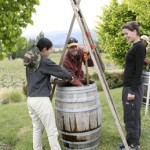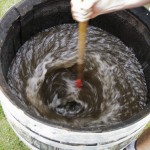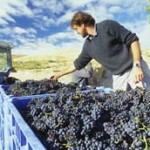Tea time for New Zealand?
Author: Guest Blogger

Nigel Greening of Felton Road Estate in New Zealand talks about biodynamics in the New World
Two of the aspects of Biodynamics which I personally find least convincing are the preparations (500-508), and the calendar. Unfortunately these are probably the two areas that also get the vast majority of the publicity associated with Biodynamic farming, largely because of the “Harry Potter makes some potions” aspect of the whole thing.
Don’t misunderstand me; I’m not suggesting that I think that the preps don’t do anything. The microbial count in Prep 500 (the overwintered cow-horn dung) is extraordinarily high and anybody who believes the commonly used statements that these preps are used in “homeopathic” doses is invited to enjoy a glass of the pungent dark brown brew. Similarly the preps used in composting only need to be seeding the compost with small amounts of micro-organisms or trace elements to have a profound effect. Whether one accepts or rejects the idea that these preparations work using some sort of cosmic force, the simple microbial effect is enough to make them far more than a placebo.
So where’s the problem? It is simply this. Nearly all the plants and animals concerned have no native place in New Zealand. Most certainly aren’t an integral part of our terroir, so why should we use them? Steiner was talking to German farmers about their problems and his observations were essentially European in nature and 1920’s in terms of context. It would be foolish to assume that his observations were somehow a divine list of the only nine effective combinations on the planet. So is there a New Zealand equivalent?
 What is intriguing about the preps is that most involve a mixture of plant and animal ingredient, which is probably a very good basis for breeding a rich diversity of bugs. He chose stags and cows because he felt that their horns, pointing to the heavens would be ideal antennae to collect waves of energy.
What is intriguing about the preps is that most involve a mixture of plant and animal ingredient, which is probably a very good basis for breeding a rich diversity of bugs. He chose stags and cows because he felt that their horns, pointing to the heavens would be ideal antennae to collect waves of energy.
For those who find this pretty eccentric, we need to consider that Steiner saw the discovery and emergence of radio waves in his lifetime. He was a young boy when the waves were first discovered and he was in his late thirties when these miraculous waves of invisible energy were first used to transmit messages over a distance using antennae. It wasn’t at all a big jump to consider that there might be more sorts of wonderful invisible energies still to be discovered or that evolution may have equipped some animals to use them. For those who ask whether the preps are somehow a concentrate of such energy, I’d suggest it doesn’t matter: all that concerns us is do they work and help you farm better?
While we have no native animals other than both flighted and flightless birds and a couple of lizards, (all of which are protected: stuffing a Kiwi with anything would land me straight in jail) today the red deer is very much a part of our landscape, far more so than in Steiner’s Germany. It may be an introduced species, but so are grape vines and deer have been in New Zealand for a lot longer than Pinot Noir has. The same is true of cattle. While some of the plants used in the preps are now found growing in New Zealand, most are hardly typical of our local flora in Central Otago so do fail the “terroir” test. Something we might start to do in the seasons to come is to do some experiments with teas made with the plants that do define our landscape. Many are introduced: the most prominent plants on our hillsides are wild briar roses that gold miners brought in for Vitamin C or the wild thyme, again from the miners. But true natives such as Manuka: the tea tree, are known for their pharmaceutical efficacy, so they might be an interesting component. As part of the drive to protect the native species, stuffing a possum with rose-hips and then doing practically anything with it would certainly attract a Government grant and have a serious resonance with local conventional farmers, let alone those of biodynamic bent.
So, we have a rich field in which to experiment.
 Similarly where does the calendar sit when our seasons are reversed, the constellations inverted and many invisible in our heavens? (One must bear in mind that those who drew the plans and theory of astrological constellations had never seen the southern skies and stars.) The short answer is: I haven’t a clue, but I suspect that is just as true for others who follow the Thun Calendar.
Similarly where does the calendar sit when our seasons are reversed, the constellations inverted and many invisible in our heavens? (One must bear in mind that those who drew the plans and theory of astrological constellations had never seen the southern skies and stars.) The short answer is: I haven’t a clue, but I suspect that is just as true for others who follow the Thun Calendar.
If this sounds like heresy, maybe it is. But I can’t help wondering whether some independent work to try to understand the influences and rhythms of our ecosystems is not overdue. Steiner was never an opponent of science: he was a great fan and wanted to reconcile the world of his more esoteric beliefs and modern scientific understanding. Bearing in mind that so much of his thinking is now mainstream: the idea of viewing land as a holistic ecosystem, his attempts to define and focus on sustainability are just two examples. We also have to accept that at his most controversial he never came up with any ideas as outlandish as quantum mechanics or string theory.
So perhaps next year when a hunter drops by to swap a deer for some wine (which is a regular occurrence, by the way), we might try a bit of thyme stuffing, so to speak. Rose-hip tea has long been enjoyed by people, perhaps the grapes would like a sip as well.


